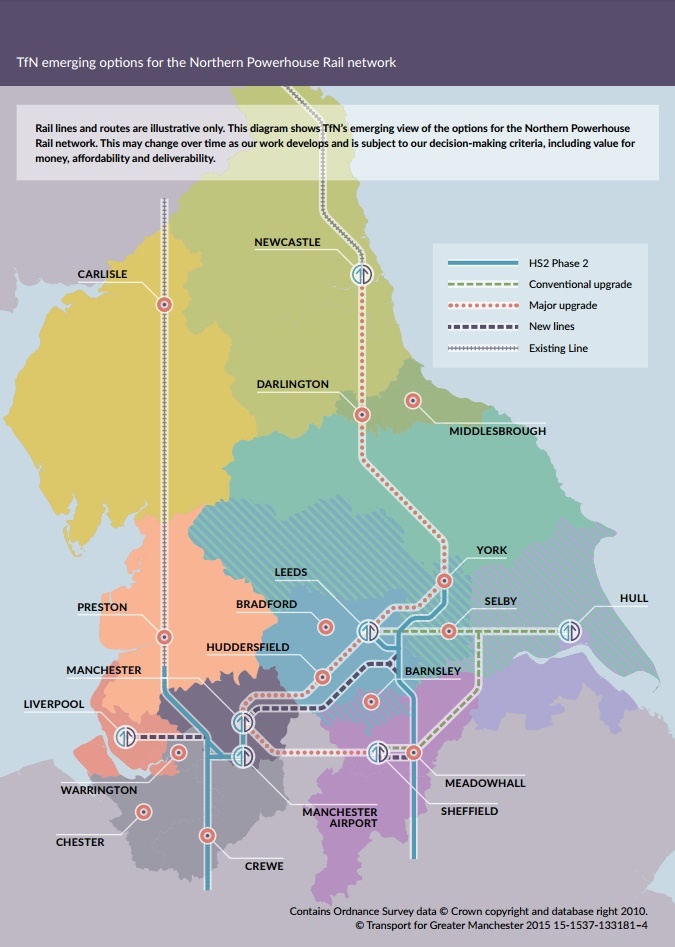07.03.16
East-west Northern Powerhouse Rail options revealed
Further details of preliminary options for the budding Northern Powerhouse Rail (NPR) have been revealed in Transport for the North’s (TfN’s) spring report, ahead of the scheme’s design development stage in 2017.
Options for the NPR network – a rail link connecting the north from east to west – include initial ideas to cut down on journey times and increase capacity between the largest cities and Manchester Airport.
Between Leeds and Manchester and Sheffield and Manchester, TfN’s work has shown it “needs to go further than committed investments” in existing routes to achieve better and more frequent services. Options being looked at include building entirely new lines for the route, or “very significant sections” of new line.
Between Leeds and Newcastle and Leeds and Hull, the TfN report said “substantial work to upgrade the existing line is likely to move us significantly towards the vision”.
Finally, between Manchester, Manchester Airport and Liverpool, there is potential to integrate the HS2 infrastructure, including the option of creating a new line.
 Click on the image to enlarge it.
Click on the image to enlarge it.
While these are all very preliminary ideas, outline feasibility work, including looking at relative costs and benefits, will be completed by autumn this year – paving the way for full assessment of each option before the end of this year.
The scheme, initially called HS3, currently represents a partnership between TfN, the Department for Transport, Network Rail and HS2, although “the most effective partnership arrangements will be determined in 2016-17 in collaboration with the DfT and its agencies”. This team will then “continue scheme development into 2017-18”. A full indicative timeline for 2016-17 can be found here.
Working together, these organisations are looking to make the case for a slice of central government’s £300m Transport Development Fund to accelerate the scheme’s development.
Investment in the NPR is also largely expected to free up capacity for freight growth, potentially taking it off the road network entirely.
On rail schemes in general, the report said: “During 2016, with a contribution from the Transport Development Fund, scheme development could go further. It would allow us by the end of the year to establish a more detailed view of the physical work required to deliver each option within a corridor.
“This includes analysis of the indicative costs and benefits, in order to move towards proposing a preferred option on each corridor. We will continue to integrate our work with the other workstreams, maximising the potential to accommodate ambitious freight growth, serving other significant economic centres and retaining the opportunity to connect the NPR network into local markets.”
The NPR scheme is also likely to feature in the Annual Update of the Northern Transport Strategy in March next year, which is set to present the priorities for the region.
Although the report highlighted ongoing developments to rail in the north, including the upcoming Northern Rail and TransPennine franchises, it reiterated what its bosses said two weeks ago: that achieving the desired rail vision could require new railway lines, major upgrades to existing lines (such as major bypasses and cut-offs) and major work at stations.
In the report’s foreword, TfN’s chair, John Cridland, noted that this required thinking long-term and differently, echoing the remarks from the organisation’s chief executive, David Brown.
“Incremental changes will not deliver the economic gains that the north requires,” Cridland added. “With government, TfN has considered pan-northern connectivity, particularly east-west movement, in new ways and in levels of detail not seen before.”
The report also listed significant upgrade work as major enablers for the northern vision, including electrification, sections of four tracking, and grade separation of key junctions between Leeds and Hull and Leeds and Newcastle.
(Top image: c. Graeme Bickerdike)